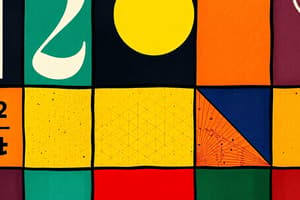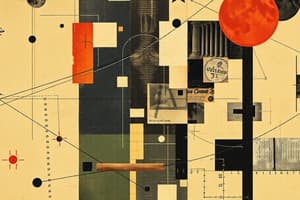Podcast
Questions and Answers
Which of the following is a core focus of arithmetic?
Which of the following is a core focus of arithmetic?
- Basic operations on numbers (correct)
- Analyzing rates of change
- Study of shapes and sizes
- Solving equations with variables
What is the purpose of using symbols (variables) in algebra?
What is the purpose of using symbols (variables) in algebra?
- To perform basic arithmetic operations
- To calculate areas of shapes
- To measure angles in triangles
- To represent unknown numbers and quantities (correct)
Which branch of mathematics deals with the properties of space and figures?
Which branch of mathematics deals with the properties of space and figures?
- Arithmetic
- Calculus
- Geometry (correct)
- Statistics
What are sine, cosine, and tangent?
What are sine, cosine, and tangent?
Which of the following is a branch of calculus?
Which of the following is a branch of calculus?
What does statistics primarily involve?
What does statistics primarily involve?
What is the correct order of operations to solve arithmetic expressions?
What is the correct order of operations to solve arithmetic expressions?
Which mathematical concept is used in fields like physics, engineering, and navigation?
Which mathematical concept is used in fields like physics, engineering, and navigation?
What does probability primarily deal with?
What does probability primarily deal with?
Which of the following is a key area within discrete mathematics?
Which of the following is a key area within discrete mathematics?
What is a central focus of number theory?
What is a central focus of number theory?
Which area of mathematics provides the foundation for reasoning and proof techniques?
Which area of mathematics provides the foundation for reasoning and proof techniques?
What is a 'set' in the context of set theory?
What is a 'set' in the context of set theory?
In a direct proof, what is the starting point?
In a direct proof, what is the starting point?
What does linear algebra primarily study?
What does linear algebra primarily study?
What is the value of $i^2$ in complex numbers?
What is the value of $i^2$ in complex numbers?
Which coordinate system uses a distance from the origin and an angle from a reference direction?
Which coordinate system uses a distance from the origin and an angle from a reference direction?
What does proof by contradiction assume?
What does proof by contradiction assume?
Flashcards
Probability
Probability
Likelihood of events occurring.
Discrete Mathematics
Discrete Mathematics
Deals with discrete, not continuous, mathematical structures.
Number Theory
Number Theory
Study of the properties and relationships of integers.
Mathematical Logic
Mathematical Logic
Signup and view all the flashcards
Set Theory
Set Theory
Signup and view all the flashcards
Direct Proof
Direct Proof
Signup and view all the flashcards
Linear Algebra
Linear Algebra
Signup and view all the flashcards
Complex Numbers
Complex Numbers
Signup and view all the flashcards
Cartesian Coordinates
Cartesian Coordinates
Signup and view all the flashcards
Polar Coordinates
Polar Coordinates
Signup and view all the flashcards
Arithmetic
Arithmetic
Signup and view all the flashcards
Algebra
Algebra
Signup and view all the flashcards
Geometry
Geometry
Signup and view all the flashcards
Trigonometry
Trigonometry
Signup and view all the flashcards
Calculus
Calculus
Signup and view all the flashcards
Statistics
Statistics
Signup and view all the flashcards
Absolute value
Absolute value
Signup and view all the flashcards
Order of operations
Order of operations
Signup and view all the flashcards
Study Notes
- Math is a broad field encompassing numerous branches and concepts, generally involving the study of quantity, structure, space, and change.
- It employs abstraction and logical reasoning to formulate and explore mathematical principles.
Arithmetic
- Arithmetic deals with basic operations on numbers: addition, subtraction, multiplication, and division.
- It is the foundation of mathematics and is used in everyday calculations.
- Key concepts include number systems (natural, integer, rational, real, complex numbers), fractions, decimals, percentages, ratios, and proportions.
- Order of operations (PEMDAS/BODMAS) is crucial for solving arithmetic expressions correctly.
Algebra
- Algebra extends arithmetic by using symbols (variables) to represent numbers and quantities.
- It involves solving equations and inequalities to find the values of unknown variables.
- Key topics include linear equations, quadratic equations, systems of equations, polynomials, factoring, and algebraic fractions.
- Graphing equations and understanding the relationship between algebraic expressions and their graphical representations are important aspects.
Geometry
- Geometry is concerned with the study of shapes, sizes, positions of figures, and the properties of space.
- It includes Euclidean geometry (dealing with flat planes and shapes), solid geometry (dealing with three-dimensional shapes), analytic geometry (using algebra to study geometric figures), and trigonometry (relating angles and sides of triangles).
- Key concepts involve points, lines, angles, planes, polygons, circles, spheres, and various geometric theorems (e.g., Pythagorean theorem).
Trigonometry
- Trigonometry focuses on the relationships between angles and sides of triangles.
- Sine, cosine, and tangent are fundamental trigonometric functions.
- It is used extensively in fields such as physics, engineering, and navigation.
- Trigonometric identities, laws of sines and cosines, and solving trigonometric equations are important topics.
Calculus
- Calculus deals with continuous change and is divided into two main branches: differential and integral calculus.
- Differential calculus concerns rates of change and slopes of curves (derivatives).
- Integral calculus deals with accumulation of quantities and areas under curves (integrals).
- Key concepts include limits, continuity, derivatives, integrals, and applications to optimization and related rates problems.
Statistics and Probability
- Statistics involves collecting, analyzing, interpreting, and presenting data.
- Probability deals with the likelihood of events occurring.
- Key concepts include measures of central tendency (mean, median, mode), measures of dispersion (variance, standard deviation), probability distributions, hypothesis testing, and statistical inference.
Discrete Mathematics
- Discrete mathematics deals with mathematical structures that are fundamentally discrete rather than continuous.
- It includes topics like logic, set theory, combinatorics, graph theory, and number theory.
- It is essential for computer science and information technology.
- Logic provides the foundation for reasoning and proof techniques.
Number Theory
- Number theory is a branch of mathematics that studies the properties and relationships of numbers, especially integers.
- It includes topics such as prime numbers, divisibility, modular arithmetic, and Diophantine equations.
- It has applications in cryptography and computer science.
- Key concepts include prime factorization, greatest common divisor (GCD), and least common multiple (LCM).
Mathematical Logic
- Mathematical logic is the study of formal systems and their application to mathematical reasoning.
- Propositional logic and predicate logic are fundamental areas.
- Concepts include logical connectives (AND, OR, NOT, IMPLIES), quantifiers (universal, existential), and proof techniques (direct proof, indirect proof, mathematical induction).
Set Theory
- Set theory is the branch of mathematics that studies sets, which are collections of objects.
- It provides a foundation for many areas of mathematics.
- Key concepts include set operations (union, intersection, complement), subsets, power sets, and relations.
- Venn diagrams are used to visualize set operations.
Proof Techniques
- Direct Proof: Start with assumptions and use logical deductions to reach the conclusion.
- Indirect Proof (Proof by Contradiction): Assume the negation of the statement and show that it leads to a contradiction.
- Proof by Induction: Prove a base case and then show that if the statement holds for some value, it also holds for the next value.
Linear Algebra
- Linear algebra studies vector spaces, linear transformations, and systems of linear equations.
- Key concepts include vectors, matrices, determinants, eigenvalues, and eigenvectors.
- It has applications in computer graphics, data analysis, and engineering.
- Matrix operations like addition, multiplication, and inversion are important tools.
Complex Numbers
- Complex numbers extend the real number system by including the imaginary unit 'i', where i² = -1.
- A complex number has the form a + bi, where a and b are real numbers.
- Complex numbers are used in various areas of mathematics, physics, and engineering.
- Operations on complex numbers include addition, subtraction, multiplication, and division.
Coordinate Systems
- Cartesian Coordinates: Uses perpendicular axes to define the position of a point in a plane or space.
- Polar Coordinates: Uses a distance from the origin (radius) and an angle from a reference direction to define the position of a point in a plane.
- Cylindrical Coordinates: Extends polar coordinates to three dimensions by adding a height coordinate.
- Spherical Coordinates: Uses a distance from the origin (radius) and two angles to define the position of a point in space.
Studying That Suits You
Use AI to generate personalized quizzes and flashcards to suit your learning preferences.




